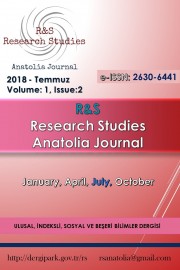UYGURCA MAİTRİSİMİT’TE ASIG TUSU İKİLEMESİ ÜZERİNE
ABOUT THE “ASIG TUSU” HANDIADYOIN IN UIGHUR MAITRISIMIT
Author(s): Sümbül Begüm YıldızSubject(s): Archaeology, Recent History (1900 till today), Sociolinguistics, Turkic languages
Published by: Arif YILDIZ
Keywords: Old Uighur; Handiadyoin; Maitrisimit; asig tusu/asag tusu;
Summary/Abstract: During the archaeological studies carried out in Eastern Turkistan by the German excavation team between 1902- 1913, many works written in old Uighur Turkish were found. One of these works is “Maitrisimit Nom Bitig”, composed of twenty eight chapters along with a prostration known to be translated from Tocharian into Turkish by Prajnarakşita, who belongs to the Buddhist Hinayana sect. This work is known to be the first theatre of the Turks. In terms of vocabulary and subject, it has an important place in the corpus of Turkish Buddhist works. There are two copies of the work, Kumul and Berlin. Many studies have been done on these two copies so far. For example, two important studies about the copy Berlin are the works of Şinasi Tekin which was his doctoral dissertation published in 1976. The study on the Kumul copy was made by Geng Shimin and published in 2009 with the addition of Chinese translation for transcription of eighteen episodes. In this report, we will focus on the handiadyoin asig tusu/asag tusu in both copies of the work. Although this handiadyoin is often written in the form of asig tusu, we can also see it as asag tusu based upon the different subdialects of Manichaeism works. This handiadyoin, which means “advantage, profit, benefit and serve” in Buddhist works, has been used in some texts as separate words, but in similar meanings. For example in Mukaddimetü’l-Edeb words which is one of the Harezm period works, it is seen that the Word “asig” is used as “assu” and in the first interpretation of Qur’an(Karakhanid Turkic), it is also seen that the word “tusu” is used as “inçlen-” separately from the word “asig”, changing in from. In this study, the hendiadyoin mentioned will be examined in terms of structure and meaning, taking into account the forms and uses of the works of old Turkish and the kinds and meanings of this handiadyoin which arise depending upon the use in a sentence with the affixes it takes will also be tried to be determined.
Journal: R&S - Research Studies Anatolia Journal
- Issue Year: 1/2018
- Issue No: 2
- Page Range: 281-288
- Page Count: 8
- Language: Turkish

